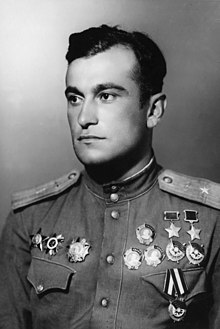Amet-khan Sultan
Amet-Khan Sultan | |
|---|---|
 | |
| Born | October 25, 1920 Alupka, South Russia |
| Died | February 1, 1971 (aged 50) Moscow Oblast |
| Allegiance | |
| Service | Soviet Air Forces |
| Rank | Podpolkovnik |
| Battles / wars | World War II |
| Awards | |

Amet-khan Sultan (Template:Lang-ru; 25 October 1920, Alupka, Crimea – 1 February 1971) was a Soviet fighter ace and test pilot whose mother was Crimean Tatar and father was an ethnic Lak.[1] Alternative spellings of his name include Ahmed Khan Sultan, Amet-Han Soultan, Ahmet-Han Sultan, Amet-Han Sultan, and Sultan Amet-Han.[citation needed]
Amet-Khan graduated from military aviation school in 1940. With the German attack on the Soviet Union in June 1941 he was a pilot with the 4th Fighter Regiment, based around Odessa, flying the I-16. He claimed his first victory on 31 May 1942, ramming a Junkers Ju-88 with his Hawker Hurricane fighter. In October 1942 he transferred to the elite 9th Guards Fighter Aviation Regiment (9th GIAP), equipped at various times with the Yak-1, P-39 Airacobra and finally the Lavochkin La-7. In action over the Briansk, south-western, Stalingrad, southern, Ukrainian, and Byelorussian fronts, Amet-Khan flew some 603 sorties participated in 150 air battles, and personally claimed 30 planes shot down, with 19 more victories shared.[2]
In 1946 he transferred to the Reserve and became a test pilot, at Gromov Flight Research Institute. He was killed in a plane crash on 1 February 1971 during a test flight on Tupolev Tu-16LL. During his lifetime he personally tested over 100 planes.
He was portrayed in the 2013 film Haytarma.[3]
Honours and awards
- Twice Hero of the Soviet Union
- Honoured Test Pilot of the USSR
- Three Orders of Lenin
- Five Orders of the Red Banner
- Order of Alexander Nevsky
- Order of the Patriotic War First Class
- Order of the Red Star
- Order of the Badge of Honour
References
Notes
- ^ Amet-khan Sultan at the site 'Heroes of the country' (in Russian)
- ^ Mellinger and Stanaway 2001, p. 85.
- ^ "Production news: Haytarma". Ukraine Film Office. 2012-10-05. Retrieved 2013-06-19.
Bibliography
- Juszczak, Artur and Pęczkowski, Robert. Bell P-39 Airacobra. Sandomierz, Poland/Redbourn, UK: Mushroom Model Publications, 2003. ISBN 83-916327-9-2.
- Loza, Dmitriy and Gebhardt, James F. (transl.). Attack of the Airacobras: Soviet Aces, American P-39s & the War Against Germany. Lawrence, Kansas: University Press of Kansas, 2002. ISBN 0-7006-1140-1.
- Mellinger, George and Stanaway, John. P-39 Airacobra Aces of World War 2. Botley, Oxford, UK: Osprey Publishing Ltd., 2001. ISBN 1-84176-204-0.
- Morgan, Hugh. Soviet Aces of World War 2. London: Reed International Books Ltd., 1998. ISBN 1-85532-632-9.
External links
- Heroes of the Soviet Union
- Recipients of the Order of Lenin
- 1920 births
- 1971 deaths
- People from Alupka
- Test pilots
- Crimean Tatar people
- Soviet World War II flying aces
- Dagestan
- Laks
- Soviet Air Force officers
- Soviet aviators
- Recipients of the Order of the Red Banner
- Recipients of the Order of Alexander Nevsky
- Recipients of the Order of the Patriotic War, 1st class
- Recipients of the Order of the Red Star
- Recipients of the Order of the Badge of Honour
